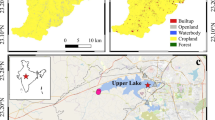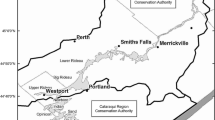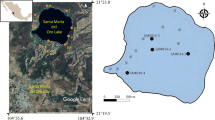Abstract
Although catchments have been implicated as an important source of metals to lakes, the catchment contribution of different metals is poorly known, and the anthropogenic contribution is not known at all. We determine the anthropogenic lake sediment burdens of Zn, Cu, Ni, Cr, and Pb for several Quebec and Ontario lakes, not subject to point source loading, to obtain estimates of atmospheric loading and inputs from terrestrial sources. To do this, we first collected multiple cores across 11 lake basins to estimate the whole-lake Pb burdens. As the whole-lake Pb burdens did not differ among lakes that spanned over two orders of magnitude in drainage ratios (drainage basin area/lake area), we conclude that catchment retention of anthropogenic Pb is complete. The anthropogenic Pb burdens were then used as a correction for focusing for the other metals. Among the metals, Cr and Ni were the most readily exported from drainage basins, followed by Cu. Zn showed no increase with drainage ratio, indicating Zn to be effectively retained by catchments. The export coefficients of the Pb corrected metals correlate well with ocean residence time, revealing a similar metal sorption/precipitation sequence in both soils and oceans. Sediment metal burdens provide a relatively easy way to obtain not only metal export coefficients from drainage basins, but also the atmospheric deposition of anthropogenic metals (e.g. Pb: S.E. Quebec, 950 mg*m−2: Laurentians, north of Montreal, 420 mg*m−2). The export coefficients are not only simpler to obtain than by mass balance measurements, but, in addition, identify the anthropogenic component.
Similar content being viewed by others
References
Broecker WS & Peng T-H (1983) Tracers in the Sea. Eldigio Press, New York, 689 p
Carignan R & Flett RJ (1981) Postdepositional mobility of phosphorus in lake sediments. Limnol. Oceanogr. 26: 361–366
Carignan R & Nriagu JO (1985) Trace metal geochemistry in the sediments of two lakes near Sudbury, Ontario. Geochim. Cosmochim. A. 49: 1753–1764
Cronan CS & Schofield CL (1979) Aluminum leaching response to acid precipitation: effects on high elevation watersheds in the north east. Science 204: 304–306
Dillon PJ, Evans HE & Scholer PJ (1988) The effects of acidification on mental budgets of lakes and catchments. Biogeochemistry 5: 201–220
Dillon PJ & Evans RD (1982) Whole lake Pb burdens in sediments of lakes in southern Ontario, Canada. Hydrobiologia 91: 121–130
Emerson S (1976) Early diagenesis in anaerobic lake sediments: chemical equilibria in interstitial waters. Geochim. Cosmochim. A. 40: 925–934
Evans HE, Smith PJ & Dillon PJ (1983) Anthropogenic zinc and cadmium burdens in sediments of selected southern Ontario lakes. Can. J. Fish. Aq. Sci. 40: 570–579
Evans LJ (1989) Chemistry of metal retention by soils. Environ. Sci. Technol. 23: 1047–1056
Evans RD (1980) Measurement of sediment accumulation and phosphorus retention using Pb-210 dating. Ph.D. Thesis. Department of Biology, McGill University, 169 p
Evans RD & Rigler FH (1985) Long distance transport of anthropogenic lead as measured by lake sediments. Water, Air, Soil Pollut. 24: 141–151
Fisher NS (1986) On the reactivity of metals for marine phytoplankton. Limnol. Oceanogr. 31: 443–449
Jackson TA, Hesslein RH & Schindler DW (1980) Experimental study of trace metal chemistry in soft water lakes at different pH levels. Can. J. Fish. Aq. Sci. 37: 387–402
Jackson LJ, Rasmussen JB, Peters RH & Kalff J (1991) Empirical relationships between the element composition of aquatic macrophytes and their underlying sediments. Biogeochemistry 12: 71–86
Janus LL & Vollenweider RA (1981) The OECD cooperative programme on eutrophication. National Water Research Institute, Canada Centre for Inland Waters, Burlington, Ontario
Jenne EA (1968) Controls on Mn, Fe, Co, Ni, Cu, and Zn concentrations in soils and water: the significant role of hydrous Mn and Fe oxides. Adv. Chem. Ser. 73: 337–387
Jeffries DS & Snyder WR (1981) Atmospheric deposition of heavy metals in Central Ontario. Wat. Air Soil. Poll. 15: 127–152
Kaiser KLE (1980) Correlation and prediction of metal toxicity to aquatic biota. Can. J. Fish. Aq. Sci. 37: 211–218
Korte NE, Skopp J, Fuller WH, Niebla EE & Alesh BA (1976) Trace element movement in soils: influence of soil physical and chemical properties. Soil Sci. 122: 350–359
Krantzberg G (1989) Accumulation of essential and nonessential metals by chironomid larvae in relation to physical and chemical properties of the elements. Can. J. Fish. Aq. Sci. 46: 1755–1761
Lafond M, Pinel-Alloul B & Ross P (1990) Biomass and photosynthesis of size-fractionated phytoplankton in Canadian Shield lakes. Hydrobiol. 196: 25–38
LaZerte B (1991) Metal transport and retention: the role of dissolved organic carbon. Proc. Third Internat. Nordic Symp. on Humic Substances 3: 71–82
Lo KSL, Yang WF & Lin YC (1992) Effects of organic matter on the specific adsorption of heavy metals by soil. Toxicol. Environ. Chem. 34: 139–153
Munger JW & Eisenreich SJ (1983) Continental-scale variations in precipitation chemistry. Environ. Sci. Technol. 17: 32A–42A
Nriagu JO (1989) Natural versus anthropogenic emissions of trace metals to the atmosphere. In: Pacyna JM & Ottar B (Eds) Control and Fate of Trace Metals (pp 3–13). Kluwer Academic Publishers, Dordrecht, 382p
Prairie YT & Kalff J (1988) Dissolved phosphorus dynamics in headwater streams. Can. J. Fish. Aq. Sci. 45: 200–209
Rowan DJ, Kalff J & Rasmussen JB (1992) Estimating the mud deposition boundary depth in lakes from wave theory. Can. J. Fish. Aq. Sci. 49: 2490–2497
Schindler DW, Hesslein RH, Wagemann R & Broeker WS (1980) Effects of acidification on mobilization of heavy metals and radionuclides from the sediments of a freshwater lake. Can. J. Fish. Aq. Sci. 37: 373–377
Schallenberg M (1992) The ecology of sediment bacteria and hypolimnetic catabolism in lakes. Ph.D. Thesis, Department of Biology, McGill University, 259 p
Schut PH, Evans RD & Scheider WA (1986) Variations in trace metal exports from small Canadian Shield watersheds. Water Air Soil Pollut. 28: 225–237
Swain EB, Engstrom DR, Brigham ME, Henning TA & Brezonik PL (1992) Increasing rates of atmospheric mercury deposition in midcontinental North America. Science 257: 784–787
Turner DR, Whitfield M & Dickson AG (1981) The equilibrium speciation of dissolved components in freshwater and seawater at 25 °C and 1 atm. pressure. Geochim. Cosmochim. A. 45: 855–881
Tyler G (1981) Leaching of metals from the A-horizon of a spruce forest soil. Water Air Soil Pollut. 15: 353–369
Tyler LD & McBride (1982) Mobility and extractability of cadmium, copper, nickel, and zinc in organic and mineral soil columns. Soil Sci. 134: 198–205
Author information
Authors and Affiliations
Rights and permissions
About this article
Cite this article
Blais, J.M., Kalff, J. Atmospheric loading of Zn, Cu, Ni, Cr, and Pb to lake sediments: The role of catchment, lake morphometry, and physico-chemical properties of the elements. Biogeochemistry 23, 1–22 (1993). https://doi.org/10.1007/BF00002920
Received:
Accepted:
Issue Date:
DOI: https://doi.org/10.1007/BF00002920




